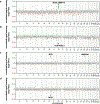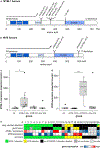Isomorphic diffuse glioma is a morphologically and molecularly distinct tumour entity with recurrent gene fusions of MYBL1 or MYB and a benign disease course
- PMID: 31563982
- PMCID: PMC7477753
- DOI: 10.1007/s00401-019-02078-w
Isomorphic diffuse glioma is a morphologically and molecularly distinct tumour entity with recurrent gene fusions of MYBL1 or MYB and a benign disease course
Abstract
The "isomorphic subtype of diffuse astrocytoma" was identified histologically in 2004 as a supratentorial, highly differentiated glioma with low cellularity, low proliferation and focal diffuse brain infiltration. Patients typically had seizures since childhood and all were operated on as adults. To define the position of these lesions among brain tumours, we histologically, molecularly and clinically analysed 26 histologically prototypical isomorphic diffuse gliomas. Immunohistochemically, they were GFAP-positive, MAP2-, OLIG2- and CD34-negative, nuclear ATRX-expression was retained and proliferation was low. All 24 cases sequenced were IDH-wildtype. In cluster analyses of DNA methylation data, isomorphic diffuse gliomas formed a group clearly distinct from other glial/glio-neuronal brain tumours and normal hemispheric tissue, most closely related to paediatric MYB/MYBL1-altered diffuse astrocytomas and angiocentric gliomas. Half of the isomorphic diffuse gliomas had copy number alterations of MYBL1 or MYB (13/25, 52%). Gene fusions of MYBL1 or MYB with various gene partners were identified in 11/22 (50%) and were associated with an increased RNA-expression of the respective MYB-family gene. Integrating copy number alterations and available RNA sequencing data, 20/26 (77%) of isomorphic diffuse gliomas demonstrated MYBL1 (54%) or MYB (23%) alterations. Clinically, 89% of patients were seizure-free after surgery and all had a good outcome. In summary, we here define a distinct benign tumour class belonging to the family of MYB/MYBL1-altered gliomas. Isomorphic diffuse glioma occurs both in children and adults, has a concise morphology, frequent MYBL1 and MYB alterations and a specific DNA methylation profile. As an exclusively histological diagnosis may be very challenging and as paediatric MYB/MYBL1-altered diffuse astrocytomas may have the same gene fusions, we consider DNA methylation profiling very helpful for their identification.
Keywords: Epilepsy; Gene fusion; Glioma; Isomorphic diffuse glioma; MYB; MYBL1.
Conflict of interest statement
Conflict of interest
D. Capper, D. T. W. Jones, A. von Deimling and S. M. Pfister declare that under the No. EP3067432A1 a patent was applied for a “DNA-methylation based method for classifying tumor species”. D. Capper and A. von Deimling are patent holders of “Methods for the diagnosis and the prognosis of a brain tumor”, the IDH1 R132H-specific antibody used in this manuscript (US 8367347 B2). The patent is under the administrative supervision of the DKFZ technology transfer office.
Figures






References
-
- Blumcke I, Aronica E, Urbach H, Alexopoulos A, Gonzalez-Martinez JA (2014) A neuropathology-based approach to epilepsy surgery in brain tumors and proposal for a new terminology use for long-term epilepsy-associated brain tumors. Acta Neuropathol 128:39–54. doi:10.1007/s00401-014-1288-9 - DOI - PMC - PubMed
Publication types
MeSH terms
Substances
Grants and funding
LinkOut - more resources
Full Text Sources
Medical
Molecular Biology Databases
Research Materials
Miscellaneous

